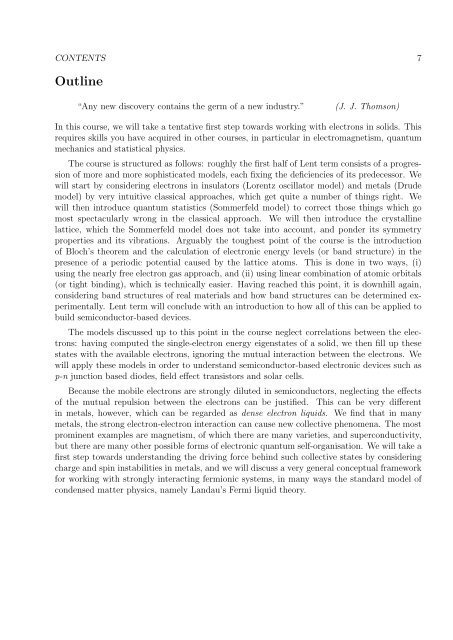Set of supplementary notes.
Set of supplementary notes.
Set of supplementary notes.
Create successful ePaper yourself
Turn your PDF publications into a flip-book with our unique Google optimized e-Paper software.
CONTENTS 7<br />
Outline<br />
“Any new discovery contains the germ <strong>of</strong> a new industry.”<br />
(J. J. Thomson)<br />
In this course, we will take a tentative first step towards working with electrons in solids. This<br />
requires skills you have acquired in other courses, in particular in electromagnetism, quantum<br />
mechanics and statistical physics.<br />
The course is structured as follows: roughly the first half <strong>of</strong> Lent term consists <strong>of</strong> a progression<br />
<strong>of</strong> more and more sophisticated models, each fixing the deficiencies <strong>of</strong> its predecessor. We<br />
will start by considering electrons in insulators (Lorentz oscillator model) and metals (Drude<br />
model) by very intuitive classical approaches, which get quite a number <strong>of</strong> things right. We<br />
will then introduce quantum statistics (Sommerfeld model) to correct those things which go<br />
most spectacularly wrong in the classical approach. We will then introduce the crystalline<br />
lattice, which the Sommerfeld model does not take into account, and ponder its symmetry<br />
properties and its vibrations. Arguably the toughest point <strong>of</strong> the course is the introduction<br />
<strong>of</strong> Bloch’s theorem and the calculation <strong>of</strong> electronic energy levels (or band structure) in the<br />
presence <strong>of</strong> a periodic potential caused by the lattice atoms. This is done in two ways, (i)<br />
using the nearly free electron gas approach, and (ii) using linear combination <strong>of</strong> atomic orbitals<br />
(or tight binding), which is technically easier. Having reached this point, it is downhill again,<br />
considering band structures <strong>of</strong> real materials and how band structures can be determined experimentally.<br />
Lent term will conclude with an introduction to how all <strong>of</strong> this can be applied to<br />
build semiconductor-based devices.<br />
The models discussed up to this point in the course neglect correlations between the electrons:<br />
having computed the single-electron energy eigenstates <strong>of</strong> a solid, we then fill up these<br />
states with the available electrons, ignoring the mutual interaction between the electrons. We<br />
will apply these models in order to understand semiconductor-based electronic devices such as<br />
p-n junction based diodes, field effect transistors and solar cells.<br />
Because the mobile electrons are strongly diluted in semiconductors, neglecting the effects<br />
<strong>of</strong> the mutual repulsion between the electrons can be justified. This can be very different<br />
in metals, however, which can be regarded as dense electron liquids. We find that in many<br />
metals, the strong electron-electron interaction can cause new collective phenomena. The most<br />
prominent examples are magnetism, <strong>of</strong> which there are many varieties, and superconductivity,<br />
but there are many other possible forms <strong>of</strong> electronic quantum self-organisation. We will take a<br />
first step towards understanding the driving force behind such collective states by considering<br />
charge and spin instabilities in metals, and we will discuss a very general conceptual framework<br />
for working with strongly interacting fermionic systems, in many ways the standard model <strong>of</strong><br />
condensed matter physics, namely Landau’s Fermi liquid theory.








